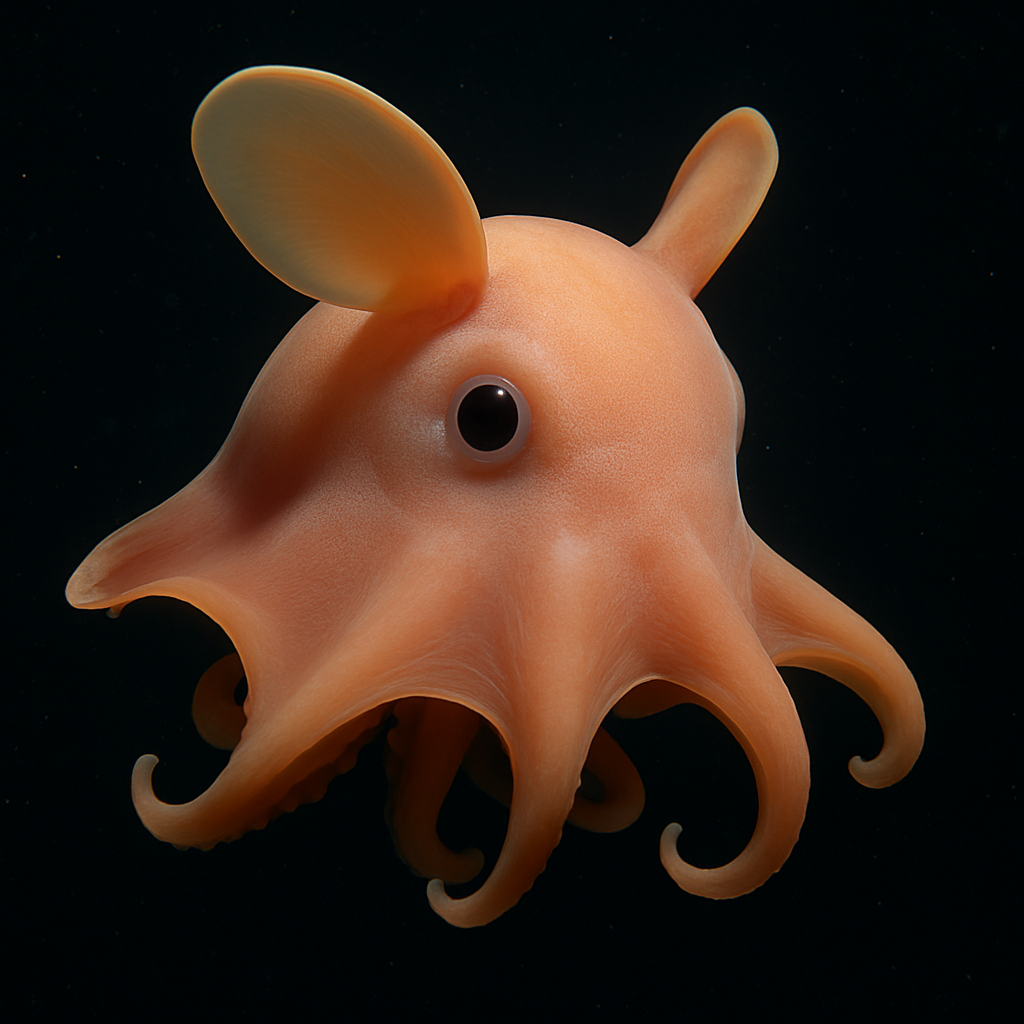The Dumbo Octopus: A Fascinating Deep-Sea Creature with Elephant-Like Ears
The Dumbo octopus is one of the most unique and mysterious creatures of the deep sea, captivating marine enthusiasts and scientists alike with its distinct appearance and behavior. Named after Disney’s iconic flying elephant, Dumbo, the octopus has large, ear-like fins that give it an almost whimsical look. But beneath its cute exterior lies a highly adaptable and efficient predator, thriving in the deep ocean’s harsh conditions.

In this article, we’ll explore the world of the Dumbo octopus, its characteristics, habitat, diet, and its fascinating behavior that makes it one of the ocean’s most intriguing creatures.
What is a Dumbo Octopus?
The Dumbo octopus belongs to the genus Grimpoteuthis and is part of the umbrella group known as “umbrella octopuses.” These creatures have been named after the Disney character because of the large, rounded fins on their bodies that resemble the elephant’s ears in the animated movie. While the Dumbo octopus is adorable, it’s also incredibly fascinating due to its ability to survive in the extreme conditions of the deep ocean.
Distinctive Features of the Dumbo Octopus
The most distinctive feature of the Dumbo octopus is its fins. These fins are located on the sides of its body, just behind the head, and are used for locomotion, much like the ears of an elephant help it steer in the air. These fins, when undulating, allow the octopus to “fly” gracefully through the water. This graceful swimming style is quite different from the typical jet propulsion movement that other octopuses use.
Dumbo octopuses also possess a gelatinous body, which helps them conserve energy while swimming in the oxygen-deprived deep-sea waters. Their soft bodies are typically translucent or pale, helping them blend into their environment. They lack the ink sacs that most other octopuses use for defense, instead relying on their camouflage abilities.
Habitat: Life in the Deep Ocean
Dumbo octopuses are found in the world’s deep oceans, typically at depths ranging from 490 feet (150 meters) to a staggering 23,000 feet (7,000 meters). They thrive in cold, dark waters that are nearly inhospitable to most marine life. This deep-sea habitat is beyond the reach of sunlight, and temperatures are just above freezing, creating a harsh environment that only a select few species can survive.
These octopuses are widely distributed, with sightings recorded across various parts of the world, from the Atlantic to the Pacific Oceans. The Dumbo octopus is found primarily in the abyssal and hadal zones of the ocean, where the pressure is immense, and the conditions are extremely challenging. Despite this, they have adapted to survive in this environment, using their slow swimming style and reliance on soft, buoyant bodies to conserve energy.
Diet: What Does the Dumbo Octopus Eat?
Dumbo octopuses are carnivorous and opportunistic feeders, preying on smaller animals that live in the depths of the ocean. Their diet mainly consists of worms, crustaceans, and small fish. As deep-sea dwellers, they often feed on creatures that have also adapted to the high pressures and low light conditions of the deep ocean.
Because of their slow swimming style, Dumbo octopuses do not actively chase prey. Instead, they ambush and capture smaller animals that cross their path, using their long arms to grab them. Their tentacles have suckers that help them hold onto their prey as they consume it. The Dumbo octopus also hunts using a unique strategy: it scours the ocean floor, sifting through sediments to find hidden prey.
Reproduction: The Life Cycle of a Dumbo Octopus
Like many deep-sea creatures, Dumbo octopuses have a mysterious and fascinating reproduction process. These octopuses lay eggs on the ocean floor, and after fertilization, the female guards the eggs until they hatch. Once the eggs hatch, the baby Dumbo octopuses are born as small versions of the adults, ready to begin their life in the deep ocean.
Unlike many other octopuses, which are semelparous (only reproduce once in their lifetime), Dumbo octopuses do not seem to have a fixed reproductive cycle. Some species of Grimpoteuthis are thought to live relatively long lives for an octopus, with some individuals surviving for several years.
Conservation: Are Dumbo Octopuses at Risk?
Due to their deep-sea habitat, Dumbo octopuses face minimal direct human threats. However, environmental changes such as ocean acidification, deep-sea mining, and trawling could disrupt their fragile ecosystem. Since these octopuses live in areas that are not heavily explored, there is still much to learn about their role in the ecosystem, and much of their behavior remains a mystery.
Researchers are also studying the effects of climate change on deep-sea creatures like the Dumbo octopus. Warming waters, ocean acidification, and changes in deep-sea food sources could have long-term impacts on their populations.
Interesting Facts About the Dumbo Octopus
- Tiny Yet Mighty: Dumbo octopuses are relatively small compared to other octopuses. The largest species of Dumbo octopus reaches a size of about 1.8 feet (55 cm), though most species are much smaller.
- No Ink: Unlike other octopuses, the Dumbo octopus does not produce ink to defend itself. Instead, it relies on its ability to hide and blend into its surroundings.
- Slow Swimmers: Dumbo octopuses swim slowly and gracefully, using their fins for propulsion rather than the usual jet propulsion method.
- Incredible Adaptations: They have adapted to the extreme conditions of the deep sea, including crushing pressure and near-freezing temperatures.
- A Rare Sight: Due to their deep-sea habitat, Dumbo octopuses are rarely seen by humans, and most of what we know comes from remote underwater explorations and deep-sea camera footage.
Conclusion
The Dumbo octopus is a mesmerizing and unique species that embodies the wonders of the deep ocean. With its distinctive appearance and remarkable adaptations, it captures the imagination of marine enthusiasts and researchers alike. While we still have much to learn about this enigmatic creature, the Dumbo octopus is a testament to the incredible diversity and mystery of life that exists in the deep, dark waters of our planet.








